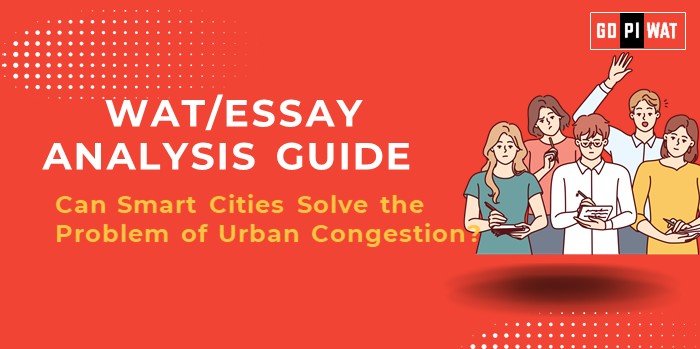📋 Written Ability Test (WAT)/Essay Analysis Guide: Can Smart Cities Solve the Problem of Urban Congestion?
🌐 Understanding the Topic’s Importance
Smart cities represent a forward-thinking approach to tackling urban congestion, a growing issue in an increasingly urbanized world. For B-school students, this topic connects with urban management, innovation, and policy design.
📝 Effective Planning and Writing
- ⏱️ Time Allocation:
- Planning: 5 minutes
- Writing: 20 minutes
- Reviewing: 5 minutes
- 📌 Preparation Tips:
- Gather data on successful smart city implementations, challenges, and potential solutions.
📖 Introduction Techniques for Essays
🎭 Contrast Approach:
“While traditional urban infrastructure struggles with congestion, smart cities offer innovative solutions but face implementation challenges.”
🔧 Solution-Based Introduction:
“Smart cities, with their focus on technology and sustainability, promise to revolutionize urban mobility and reduce congestion.”
📜 Historical Context:
“From early city planning to the integration of AI, urban development has always evolved to meet congestion challenges.”
📚 Structuring the Essay Body
🏆 Achievements:
- Discuss successful smart city initiatives and their impact on congestion.
- Example: “Singapore’s smart traffic system reduced travel delays by 15%, showcasing technology’s potential in urban mobility.”
⚠️ Challenges with Comparative Analysis:
- Examine barriers like costs and inequities.
- Example: “Despite its success, Barcelona’s IoT parking faced criticism for marginalizing low-income areas without smartphone access.”
🔮 Future Outlook:
- Propose ways to integrate smart city strategies with inclusivity.
- Example: “Public-private partnerships and affordable technology solutions can bridge gaps in smart city implementation.”
📌 Concluding Effectively
⚖️ Balanced Perspective:
“Smart cities have significant potential to mitigate congestion, but addressing socioeconomic challenges is key to their success.”
🌍 Global Comparison:
“Drawing lessons from cities like Singapore and Amsterdam, smart cities must prioritize both innovation and inclusivity.”
🔍 Analyzing Successes and Shortcomings
- ✅ Key Achievements: Enhanced traffic flow, reduced commute times, and better public transport systems.
- ⚠️ Ongoing Challenges: High costs, digital inequality, and privacy concerns.
- 🌍 Global Context: Singapore’s AI-powered traffic and Amsterdam’s smart cycling initiatives.
💡 Recommendations for Sustainable Progress
- Promote equitable access to technology.
- Encourage investments in cost-effective smart solutions.
- Strengthen data privacy regulations to ensure public trust.
📄 Sample Short Essays
⚖️ Balanced Perspective:
“While smart cities can reduce urban congestion, their success relies on equitable access and sustainable implementation.”
🔧 Solution-Oriented:
“Integrating AI and IoT with urban infrastructure can transform cities into congestion-free, efficient hubs.”
🌍 Global Comparison:
“Singapore’s AI-led traffic systems demonstrate how smart cities can effectively tackle congestion with proper planning.”
🎓 Insights for Impactful Discussions
- Highlight case studies of smart cities like Singapore and Amsterdam.
- Explore the interplay between technology, policy, and inclusivity in urban development.


